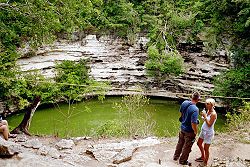Itza people
| Total population | |
|---|---|
| 2,926 Roman Catholic, Evangelical ) |


The Itza are a
Numbers of ethnic group members and Itza speakers
According to the census of 2002, there are 1,983 ethnic Itza,
In Yucatán
The Itza were descended from the Ah Itzá Yucatecan Maya lineage; historically they were an important
. Chichen Itza means 'at the mouth of the well of the Itza' in the Itza language.The books of Chilam Balam recount the history of the Itza and the demise of their empire at the hands of a band of Mexicanized Putún Maya led by the mercenary king Hunac Ceel, founder of the Cocom dynasty of Mayapan. Hunac Ceel fought the Itzas but was taken captive and was to be sacrificed by being thrown into the cenote of Chichén Itzá. However, he survived the attempted sacrifice, and having spent a night in the water he was able to relate a prophecy of the rain god Chac about the year's coming harvest. Once lord of Mayapan, he orchestrated, aided by sorcery, the destruction of Chichén Itzá.

While part of the story of Hunac Ceel seem to be more mythical than historical, it is generally accepted that the Itza of Chichén Itzá were the eventual losers in a power struggle between the three Yucatecan lineages of the Cocom, the Xiu and the Itzá, all claiming heritage from the Toltecs. And around 1331 archeological remains attest that Chichén Itzá and other Itza dominated sites, for example Isla Cerritos, were abandoned. The fall of these sites was contemporary with a gradual incursion of Mexicanized Putún Maya from Tabasco and central Mexico, and it seems that these were indeed the people who caused the fall of the original Itza state.
In Petén
The Itza then left or were expelled from the Yucatán region and returned south to the Petén Basin region to build the city Nojpetén as their capital. Noj peten means "great island" in Itza'.[7] The early Spanish accounts referred to it as Tayasal, derived from the Nahuatl tah itza ("place of the Itzá").[8]
The Itza' were at the height of their territorial expansion when Cortes arrived on the coastal cities of Chakán Putum and Potonchán in 1519. The Itza' empire covered 230,000 square kilometers, organised into 4 main kingdoms, all of which were subordinate to the Itza':
The Nahua princess
In 1523, after the fall of the Aztecs,
The Itza' were the last Maya kingdom to remain independent of the Spanish, and some Spanish priests peacefully visited and preached to the last Itza king as late as 1696. On March 13, 1697, the Itza kingdom finally submitted to Spanish rule, represented by a force led by
See also
- Chichen Itza
- Itza language
- Kukulkan
- Morzillo
Notes
- ^ "Resultados 2018" (PDF). Instituto Nacional de Estadistica Guatemala. Archived (PDF) from the original on 6 July 2020. Retrieved 9 May 2020.
- ^ "XI Censo Nacional de Población y VI de Habitación (Censo 2002) – Pertenencia de grupo étnico". Instituto Nacional de Estadística. 2002. Archived from the original on 12 June 2008. Retrieved 2009-12-22.
- ^ "Itza' A language of Guatemala". ethnologue. 1986. Archived from the original on 2012-10-27. Retrieved 2008-06-02.
- ^ "XI Censo Nacional de Población y VI de Habitación (Censo 2002) – Idioma o lengua en que aprendió a hablar". Instituto Nacional de Estadística. 2002. Archived from the original on 2011-09-28. Retrieved 2009-12-22.
- ^ Schele & Matthews 1999, p.63.
- ^ Drew 1999, p.373.
- ^ Reina 1966, p. 20.
- ^ Rice 2009, p. 43.
- ^ Atran, Scott; Lois, Ximena; Ucan Ek', Edilberto (2004) Plants of the Peten Itza Maya, Memoirs of the Museum of Anthropology, University of Michigan, 38
References
- Drew, David (1999) The Lost Chronicles of the Maya Kings, Weidenfeld & Nicolson, London. ISBN 0-297-81699-3
- Reina, Ruben E. (Fall 1966). "A Peninsula That May Have Been an Island: Tayasal, Peten, Guatemala" (PDF). Expedition. 9 (1). Philadelphia, Pennsylvania, USA: University of Pennsylvania Museum of Archaeology and Anthropology. ISSN 0014-4738. Archived from the original(PDF) on 2023-05-17. Retrieved 2013-02-01.
- Rice, Prudence M. (2009a). "The Kowoj in Geopolitical-Ritual Perspective". In Rice, Prudence M.; Rice, Don S. (eds.). The Kowoj: identity, migration, and geopolitics in late postclassic Petén, Guatemala. Boulder, Colorado, US: OCLC 225875268.
- Schele & Matthews (1999) The Code of Kings: The language of seven sacred Maya temples and tombs, Touchstone/Simon & Schuster, New York. ISBN 978-0-684-85209-6.
- Sharer, Robert J. (1994). The Ancient Maya. Stanford University Press. ISBN 0-8047-2130-0.
- Weaver, Muriel Porter (1993). The Aztecs, Maya, and Their Predecessors: Archaeology of Mesoamerica (3rd ed.). San Diego: Academic Press. ISBN 0-01-263999-0.

